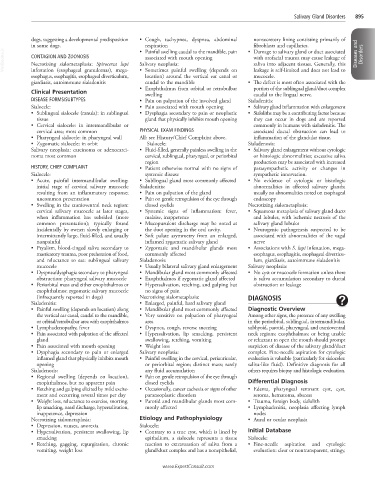Page 1788 - Cote clinical veterinary advisor dogs and cats 4th
P. 1788
Salivary Gland Disorders 895
dogs, suggesting a developmental predisposition • Cough, tachypnea, dyspnea, abdominal nonsecretory lining consisting primarily of
respiration
fibroblasts and capillaries.
in some dogs. • Painful swelling caudal to the mandible, pain • Damage to salivary gland or duct associated
VetBooks.ir CONTAGION AND ZOONOSIS Salivary neoplasia: with orofacial trauma may cause leakage of Diseases and Disorders
associated with mouth opening
saliva into adjacent tissues. Generally, this
Necrotizing sialometaplasia: Spirocerca lupi
infestation (esophageal granulomas), mega-
mucocele.
esophagus, esophagitis, esophageal diverticulum, • Sometimes painful swelling (depends on leakage is self-limited and does not lead to
location) around the vertical ear canal or
giardiasis, autoimmune sialadenitis caudal to the mandible • The defect is most often associated with the
• Exophthalmus from orbital or retrobulbar portion of the sublingual gland/duct complex
Clinical Presentation swelling caudal to the lingual nerve.
DISEASE FORMS/SUBTYPES • Pain on palpation of the involved gland Sialadenitis:
Sialocele: • Pain associated with mouth opening • Salivary gland inflammation with enlargement
• Sublingual sialocele (ranula): in sublingual • Dysphagia secondary to pain or neoplastic • Sialoliths may be a contributing factor because
tissue gland that physically inhibits mouth opening they can occur in dogs and are reported
• Cervical sialocele: in intermandibular or commonly in humans with sialadenitis. The
cervical area; most common PHYSICAL EXAM FINDINGS associated ductal obstruction can lead to
• Pharyngeal sialocele: in pharyngeal wall All: see History/Chief Complaint above. inflammation of the glandular tissue.
• Zygomatic sialocele: in orbit Sialocele: Sialadenosis:
Salivary neoplasia: carcinoma or adenocarci- • Fluid-filled, generally painless swelling in the • Salivary gland enlargement without cytologic
noma most common cervical, sublingual, pharyngeal, or periorbital or histologic abnormalities; excessive saliva
region production may be associated with increased
HISTORY, CHIEF COMPLAINT • Patient otherwise normal with no signs of parasympathetic activity or changes in
Sialocele: systemic disease sympathetic innervation.
• Acute, painful intermandibular swelling: • Sublingual gland most commonly affected • No evidence of cytologic or histologic
initial stage of cervical salivary mucocele Sialadenitis: abnormalities in affected salivary glands;
resulting from an inflammatory response; • Pain on palpation of the gland usually no abnormalities noted on esophageal
uncommon presentation • Pain on gentle retropulsion of the eye through endoscopy
• Swelling in the cranioventral neck region: closed eyelids Necrotizing sialometaplasia:
cervical salivary mucocele at later stages, • Systemic signs of inflammation: fever, • Squamous metaplasia of salivary gland ducts
when inflammation has subsided (more malaise, inappetence and lobules, with ischemic necrosis of the
common presentation); typically found • Mucopurulent discharge may be noted at salivary gland lobules
incidentally by owner; slowly enlarging or the duct opening in the oral cavity. • Neurogenic pathogenesis suspected to be
intermittently large, fluid-filled, and usually • Soft palate asymmetry from an enlarged, associated with abnormalities of the vagal
nonpainful inflamed zygomatic salivary gland nerve
• Ptyalism, blood-tinged saliva secondary to • Zygomatic and mandibular glands most • Associations with S. lupi infestation, mega-
masticatory trauma, poor prehension of food, commonly affected esophagus, esophagitis, esophageal diverticu-
and reluctance to eat: sublingual salivary Sialadenosis: lum, giardiasis, autoimmune sialadenitis
mucocele • Usually bilateral salivary gland enlargement Salivary neoplasia:
• Dyspnea/dysphagia secondary to pharyngeal • Mandibular gland most commonly affected • No cyst or mucocele formation unless there
obstruction: pharyngeal salivary mucocele • Exophthalmos if zygomatic gland affected is saliva accumulation secondary to ductal
• Periorbital mass and either enophthalmos or • Hypersalivation, retching, and gulping but obstruction or leakage
exophthalmos: zygomatic salivary mucocele no signs of pain
(infrequently reported in dogs) Necrotizing sialometaplasia: DIAGNOSIS
Sialadenitis: • Enlarged, painful, hard salivary gland
• Painful swelling (depends on location) along • Mandibular gland most commonly affected Diagnostic Overview
the vertical ear canal, caudal to the mandible, • Very sensitive on palpation of pharyngeal Among other signs, the presence of any swelling
or orbital/retrobulbar area with exophthalmos area in the periorbital, sublingual, intermandibular,
• Lymphadenopathy, fever • Dyspnea, cough, reverse sneezing subhyoid, parotid, pharyngeal, and cranioventral
• Pain associated with palpation of the affected • Hypersalivation, lip smacking, persistent neck regions; exophthalmos; or being unable
gland swallowing, retching, vomiting or reluctant to open the mouth should prompt
• Pain associated with mouth opening • Weight loss suspicion of disease of the salivary gland/duct
• Dysphagia secondary to pain or enlarged Salivary neoplasia: complex. Fine-needle aspiration for cytologic
inflamed gland that physically inhibits mouth • Painful swelling in the cervical, periauricular, evaluation is valuable (particularly for sialoceles:
opening or periorbital region; distinct mass; rarely saliva-like fluid). Definitive diagnosis for all
Sialadenosis: any fluid accumulation others requires biopsy and histologic evaluation.
• Regional swelling (depends on location), • Pain on gentle retropulsion of the eye through
exophthalmos, but no apparent pain closed eyelids Differential Diagnosis
• Retching and gulping elicited by mild excite- • Occasionally, cancer cachexia or signs of other • Edema, pharyngeal remnant cyst, cyst,
ment and occurring several times per day paraneoplastic disorders seroma, hematoma, abscess
• Weight loss, reluctance to exercise, snorting, • Parotid and mandibular glands most com- • Trauma, foreign body, sialolith
lip smacking, nasal discharge, hypersalivation, monly affected • Lymphadenitis, neoplasia affecting lymph
inappetence, depression nodes
Necrotizing sialometaplasia: Etiology and Pathophysiology • Aural or ocular neoplasia
• Depression, nausea, anorexia Sialocele:
• Hypersalivation, persistent swallowing, lip • Contrary to a true cyst, which is lined by Initial Database
smacking epithelium, a sialocele represents a tissue Sialocele:
• Retching, gagging, regurgitation, chronic reaction to extravasation of saliva from a • Fine-needle aspiration and cytologic
vomiting, weight loss gland/duct complex and has a nonepithelial, evaluation: clear or nontransparent, stringy,
www.ExpertConsult.com

